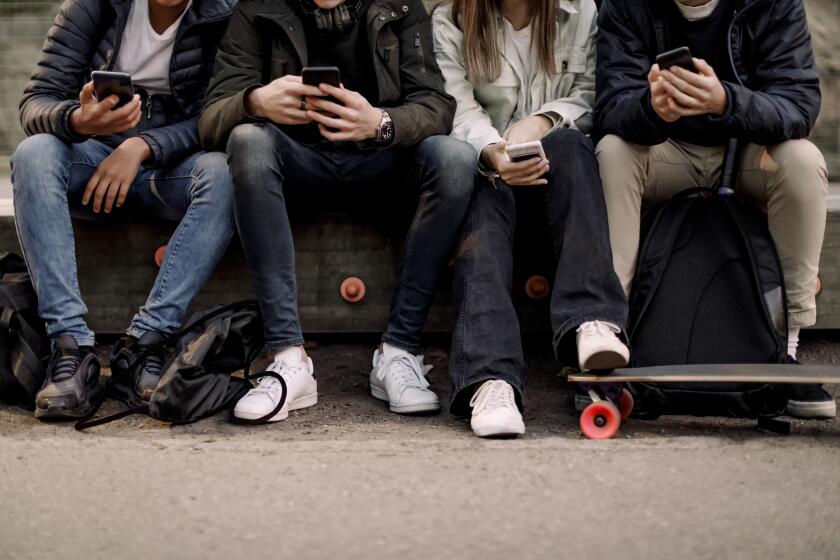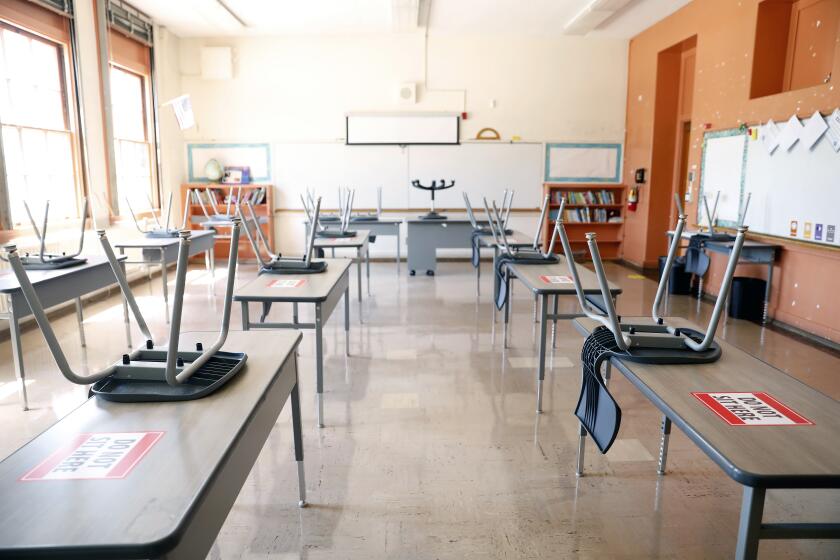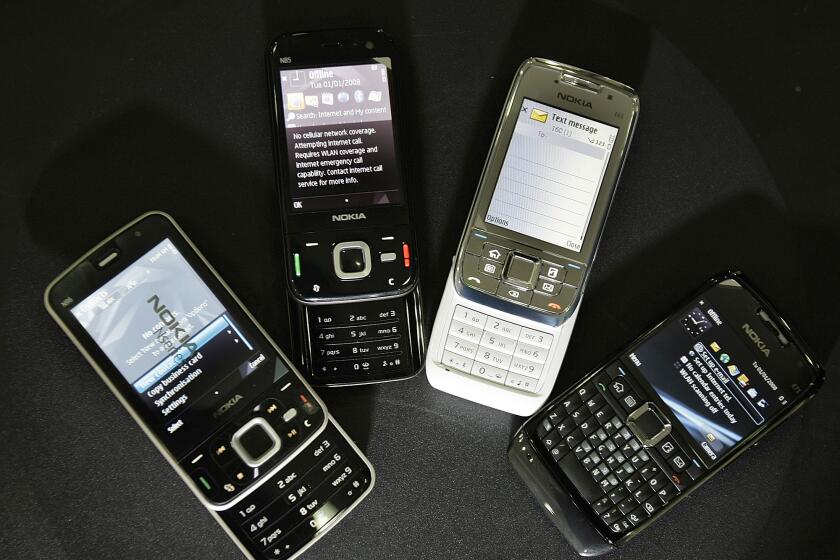Column: Los Angeles public schools will ban cellphones. What’s not to like?

- Share via
Every time I write about smartphones taking a toll on adolescents, I get tut-tutted by critics accusing me of promoting moral panic.
That’s just silly.
I am not here to debate whether phones have contributed to an increase in anxiety, depression or low self-esteem among minors. Plenty of experts are studying that, and they are getting plenty of conflicting results.
But I am here to tell you that if you are raising a young teenager, you must know in your bones that worrying about smartphones and social media is not some irrational, “Reefer Madness”-style reaction to change.
L.A.’s principals and teachers need a policy aligned with current research, which shows that curbing phone use in schools leads to better academic performance and less cyberbullying.
It’s as plain as the noses on our children’s faces — which, by the way, are constantly buried in their phones. Find me a parent who does not regularly battle with their child about putting away the smartphone — at the dinner table, with friends, in the car, on the sidewalk, at the beach, at the mall, on their bicycles — and I will find you a parent who is deployed, detached or dead. Let’s be honest: Our children are addicted.
It’s very difficult to control our kids’ smartphone use outside school, but there’s no reason we can’t control their smartphone use during school. In fact, educators all over the world are coming around to that point of view.
Some schools use lockers to store the phones; others use pouches that lock until they are tapped against a magnetic device at the schoolhouse door.
Los Angeles Unified replaced junior high with a model that tends to students’ needs at a delicate age. That doesn’t make it easy for anyone.
In a recent Times opinion essay, Los Angeles Board of Education member Nick Melvoin called for a ban on smartphones in L.A.’s public schools.
“Curbing phone usage in the classroom increases academic performance, with test score gains akin to gains made when an hour is added to the school week,” he wrote. In Spain, he added, the test scores of students at schools that have banned smartphones have risen, accompanied by a “significant drop in cyberbullying.”
Closer to home, Melvoin noted, a few Los Angeles public schools have already implemented phone bans. “School principals in LAUSD who have implemented phone-free school day policies report that fighting is down, student engagement is up and the overall campus environment is more positive,” he wrote.
Melvoin’s resolution directing the district’s staff to develop a phone ban was passed by the board Tuesday.
A middle school principal and father grew concerned about people’s relationships with their smartphones. So he opted for a dramatic tech downgrade.
Fortunately, the chorus for banning smartphones in schools is getting louder.
Last month, the California Assembly passed a bill that would prohibit smartphone use by students in public schools. The bill is now being considered in the state Senate.
On Monday, the U.S. surgeon general, Dr. Vivek Murthy, said he would ask Congress to require warning labels on social media apps.
“It is time to require a surgeon general’s warning label on social media platforms, stating that social media is associated with significant mental health harms for adolescents,” he wrote in the New York Times. A warning label, he wrote, “would regularly remind parents and adolescents that social media has not been proved safe.”
Smartphones have been causing tension in my home for years. After my niece moved in with me in 2019, at age 8, she talked incessantly about wanting a phone. Later, we signed the “Wait Until 8th” pledge not to get her one until the end of middle school, but she hounded me for an iPhone sooner because most of her friends had one. I was determined to hold the line, and did.
Man, though, was she persistent. In seventh grade, she composed a 10-point declaration, “Reasons I Should Get an iPhone.”
She was hardly device-deprived. She had a Gabb phone, which looks like an iPhone but can be used only to make and receive phone calls, texts and photos. It’s not internet-equipped, so it has no apps or social media. But she did have an iPad and access to Snapchat, her preferred social media platform, and Roblox, the game app, to play with friends.
She was smart about how she ordered her argument for a smartphone, starting with logic and then going for the emotional jugular.
“Number 1) To scan QR codes: I need to for my whole life because people don’t wanna make paper menus or just print out things anymore.”
I had noticed that displays at her middle school’s science fair included QR codes for information about the experiments. Some school announcements also included QR codes. If she could not scan them, would she be missing out on important information?
“Number 2) Listen to music: I picked this one because I have to record stuff on my phone to listen to music. Also, if you’re about to say what about your iPad, I can’t carry my iPad walking home from school.”
And then, clever girl, she played the fear card:
“Number 5) Facetime: On my phone, I can only call audio. I would like Facetime in case I need to tell someone where I am for emergencies.”
“Number 7) Looking up things: If I am ever walking home or alone anywhere I would wanna be able to look where I am. Or how to get out of wherever I am.”
All that is true, of course.
But one of the beautiful things about smartphones is the “Find My” function. Using my smartphone, I can always see where she is, or at least where her phone is.
If it’s safely locked away during school hours, so much the better.
More to Read
A cure for the common opinion
Get thought-provoking perspectives with our weekly newsletter.
You may occasionally receive promotional content from the Los Angeles Times.














